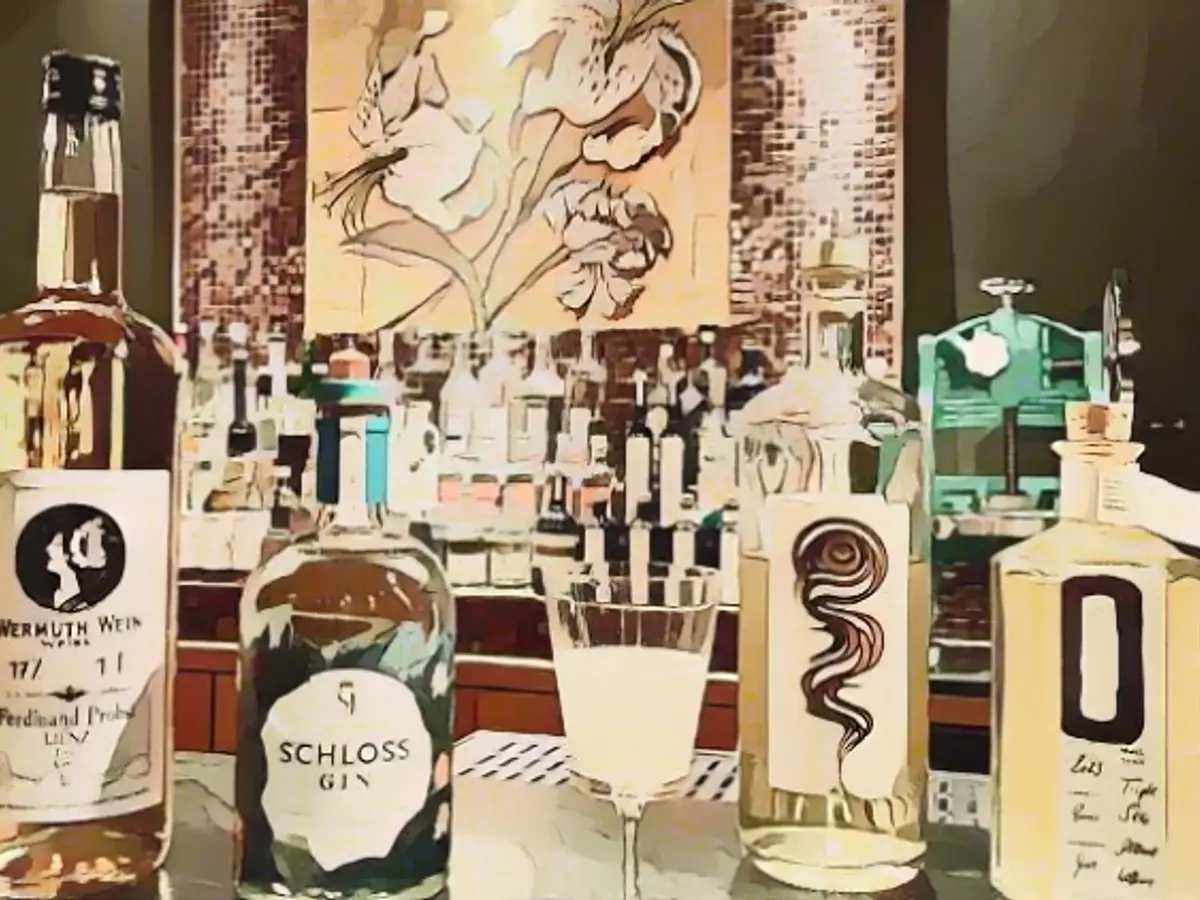Bitter truths at Christmas? Not with these drinks
Vermouth, vodka, whisky and gin anyway - German winegrowers and distilleries are producing more and more spirits that used to come from faraway lands. Our author was able to test whether and how they are suitable for cocktails in the Berlin bar "Becketts Kopf". His conclusion: "Mixing is possible!"
If the reporter's problem is often finding the entry point for a story, he struggles to find the exit for this text. Timing is always an art when dealing with the legal drug alcohol. And when the ethanol is bursting with aromatic variety and beguiling mixes, the view of the clock becomes more blurred with every sip and the desire to make research a life's work becomes more appealing.
All the more so when the man at the bar is as experienced and patient as Oliver Ebert, who runs the bar "Beckett's Kopf" in Berlin's Pappelallee. On a pre-Christmas afternoon, he complies with the request to prepare a range of traditional mixed drinks using only German ingredients.
- two "Dry Martinis" with gin and vermouth and a third with vodka on the side
- a "Manhattan" with rye whisky and vermouth
- a "Straits Sling" - strictly speaking not a "cocktail", but a "long drink" or "highball" - with gin and cherry and herb liqueur
- a - fitting at this point - "Corpse Reviver" with gin and absinthe
- and finally, as a specialty of the bar, a "Von Ribbeck" with rye whisky and pear brandy
The "InSPIRITation" came from the Moselle
The project, which is rather provincial in the world of cocktails, was inspired by a winery on the Moselle of all places. As a guest of Ernst Loosen on a rainy Advent Sunday, the reporter tasted various Rieslings from the best vineyards until the wine baron pulled out a bottle that was incredibly bulbous by Mosel standards: a pretty label with colorful plants on the outside, vermouth on the inside, i.e. a wine from the "Ürziger Würzgarten" spiced up with alcohol and eleven plant extracts - "botanicals" in the new German term. Loosen assured: "Even the lemons are from us. You have to try it! Pure or for mixing!"
Loosen's word in the reporter's ear. But can such a Mosel vermouth be used as a dry vermouth, as is traditionally used in cocktails from France, Italy or Spain? The much-praised "serving residual sweetness" in Mosel wines is unmistakable in Loosen's vermouth - and the opposite of "dry".
The reporter wanted to find out and called Oliver Ebert, who does not primarily stir and shake local ingredients in his bar "Beckett's Kopf", but he does like to do so. He is also a member of the "Freimeisterkollektiv", an exclusive association of small spirits producers and processors, quite a few of them in Germany. They agreed on a private mixology experiment - "two hours, then I have to go and eat something before the paying guests arrive", Ebert emphasized. The dilemma of getting out on time was pre-programmed.
First of all, it is advisable not to confuse this classic mixology tour with the Italian mass brand "Martini", which also produces vermouth. Rather, the "Dry Martini" is a cocktail with mainly gin and a little vermouth - the less, the drier. This can go so far that dryness fetishists only allow the shadow of a vermouth bottle into their glass. And even those who like it "sweet" should use German Riesling vermouth with caution. A warning in advance! Oliver Ebert succeeds in creating three beautiful and very different combinations.
First round: Gin
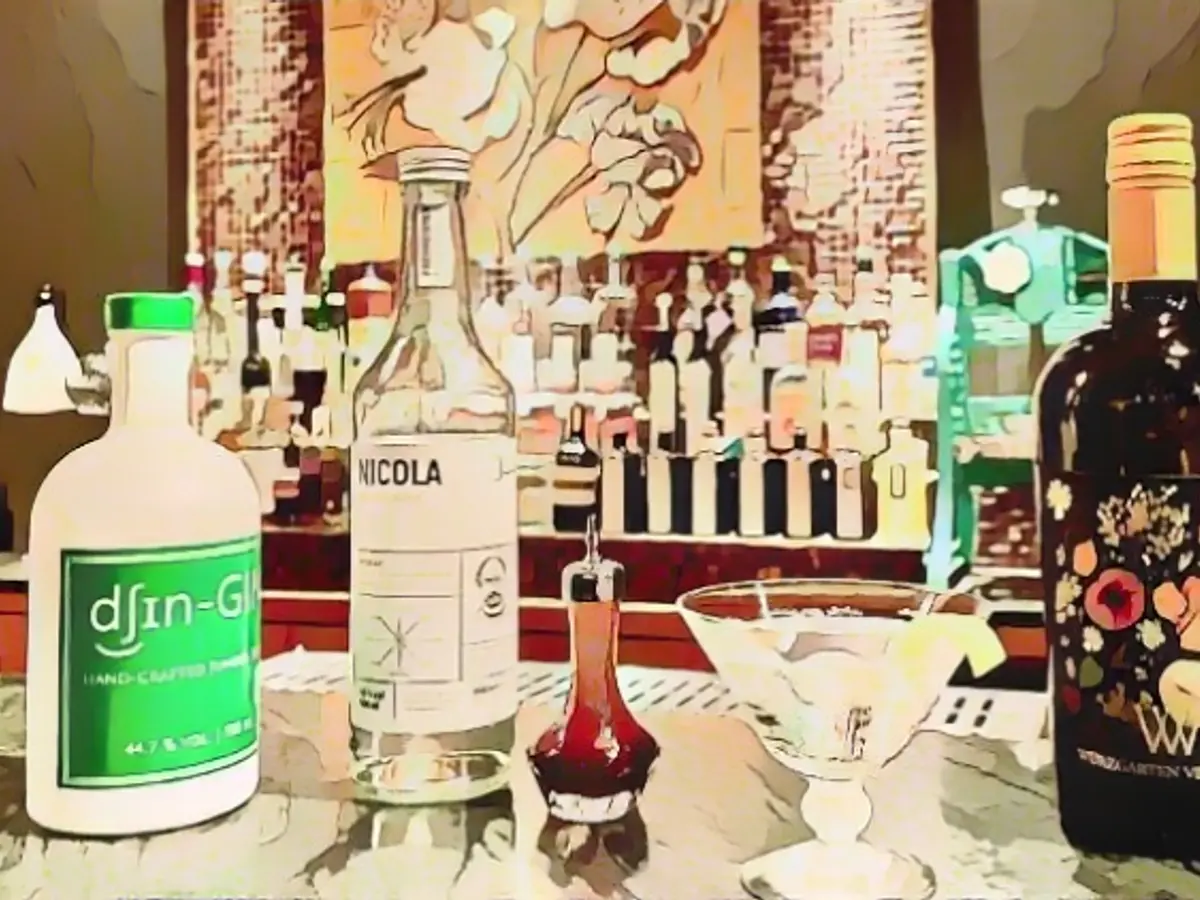
1) The first gin to be used is called "Djin" from the Heinz Eggert distillery in Lüneburg Heath. The reporter has brought it with him and as unusual as the name and the cloudy white bottle with a green lid may be, this juniper spirit has it all - in the best sense of the word: fine citrus notes, slightly peppery and ethereal. Stirred ice-cold with a little of Loosen's Würzgarten vermouth (gin at least three parts, Würzgarten maximum one part) and a dash of orange bitters from the Bavarian manufacturer Bitter Truth, a "Dry Martini" unfolds as it is written in the bar book - only with ingredients that no-one has yet noted in this combination. If you can actually get hold of a lemon from Germany to squeeze the oil from the zest onto the surface, you have a first-class evening drink in your hands - 100% made in Germany!
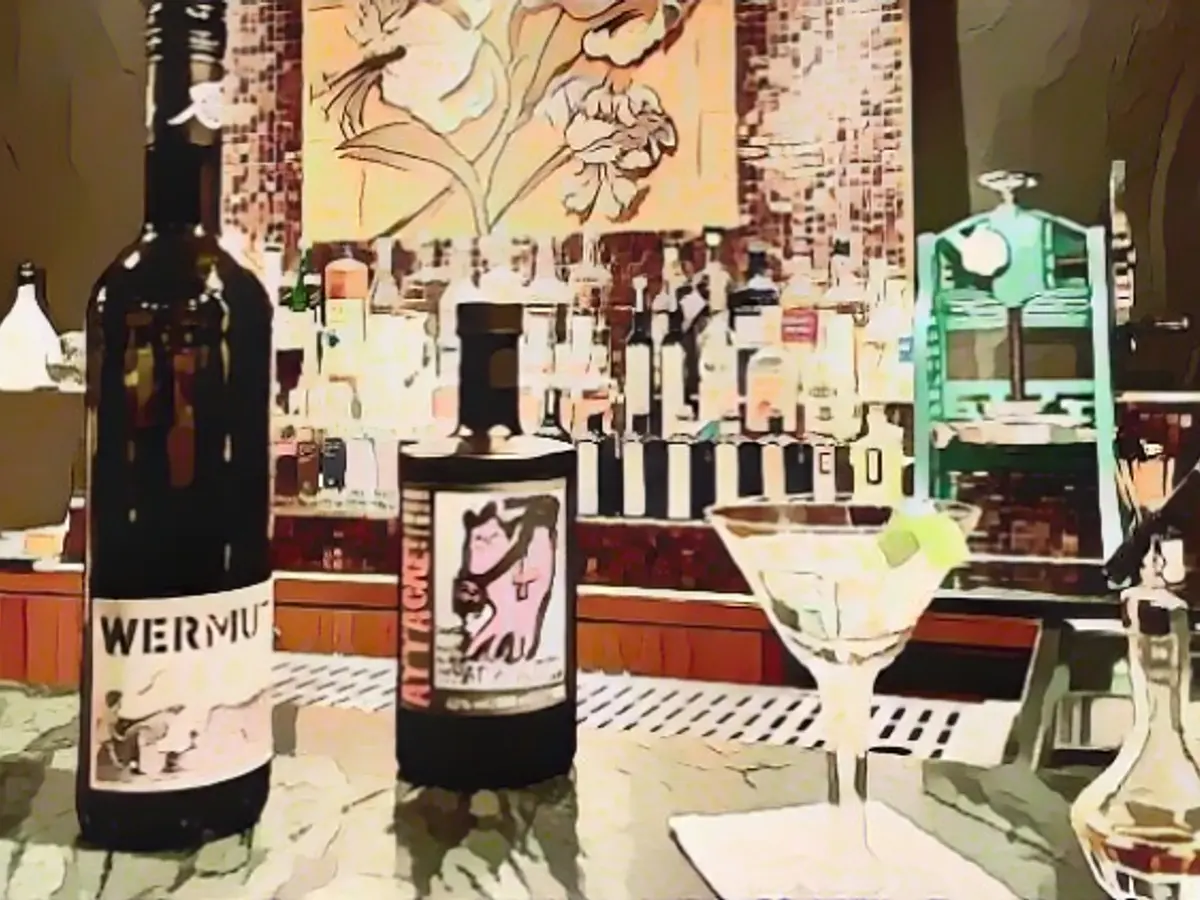
2. the second "Dry Martini" tastes "unclassical", as Ebert emphasizes: like coriander, liquorice, cardamom, a little caraway and bitter notes. This is partly due to the unusual "Niederrhein Gin" called "Attacke" from the Mühle 4 distillery, which is part of the bar's range. Another ice-cold addition is a "vermouth" with the same name, which the reporter discovered. It is produced by the steep slope vineyard Immich-Batterieberg in Moselle - also with Riesling, but in contrast to Loosen's spice paradise with only three herbs: Hawthorn, rosehip and Artemisia Absinthium - wormwood!

3 For the third "Martini", Ebert takes the first combination of Djin and Würzgarten Wermut and adds two more: the potato spirit "Nicola" from the Freimeisterkollektiv and a drop of cinchona bark - which, despite climate change, does not yet grow in Germany. Shaken (and with olive), it becomes James Bond's legendary "Vesper Martini", which author Ian Fleming was once actually served in Berlin: by Hans August Schröder, the founder of the "Rum Trader" bar. Under his successor Gregor Scholl at the latest, it became world-famous like the "Vesper" - but is now history as the "Institute for Advanced Drinking".
Second round: "Manhattan"
The "Manhattan" is one of the oldest cocktails in the world, and there are as many different recipes as there are ingredients: various whiskies, even cognacs, plus vermouths, bitters and all in varying quantities. Ebert opts for the rye whisky "094" from the Rüdiger Sasse distillery in Münsterland and a red vermouth in equal proportions. The reporter contributes the "Ferdinand Red Vermouth" from the Saar wine estate Forstmeister Geltz Zilliken. Meanwhile, Ebert stirs in a spoonful of the brand new bitter orange liqueur (also known as "Triple Sec") from Spiritus Rex Malente and a shot of "Bogart's Bitter" from Bitter Truth. The reporter tastes it, keeps quiet for once and thanks the barman: "The clove, cinnamon and star anise in the triple sec make the drink taste pleasantly like Christmas. Ebert soberly points out: "Where cinnamon and star anise grow, Christmas is rather unknown."
Third round: "Straits Sling"
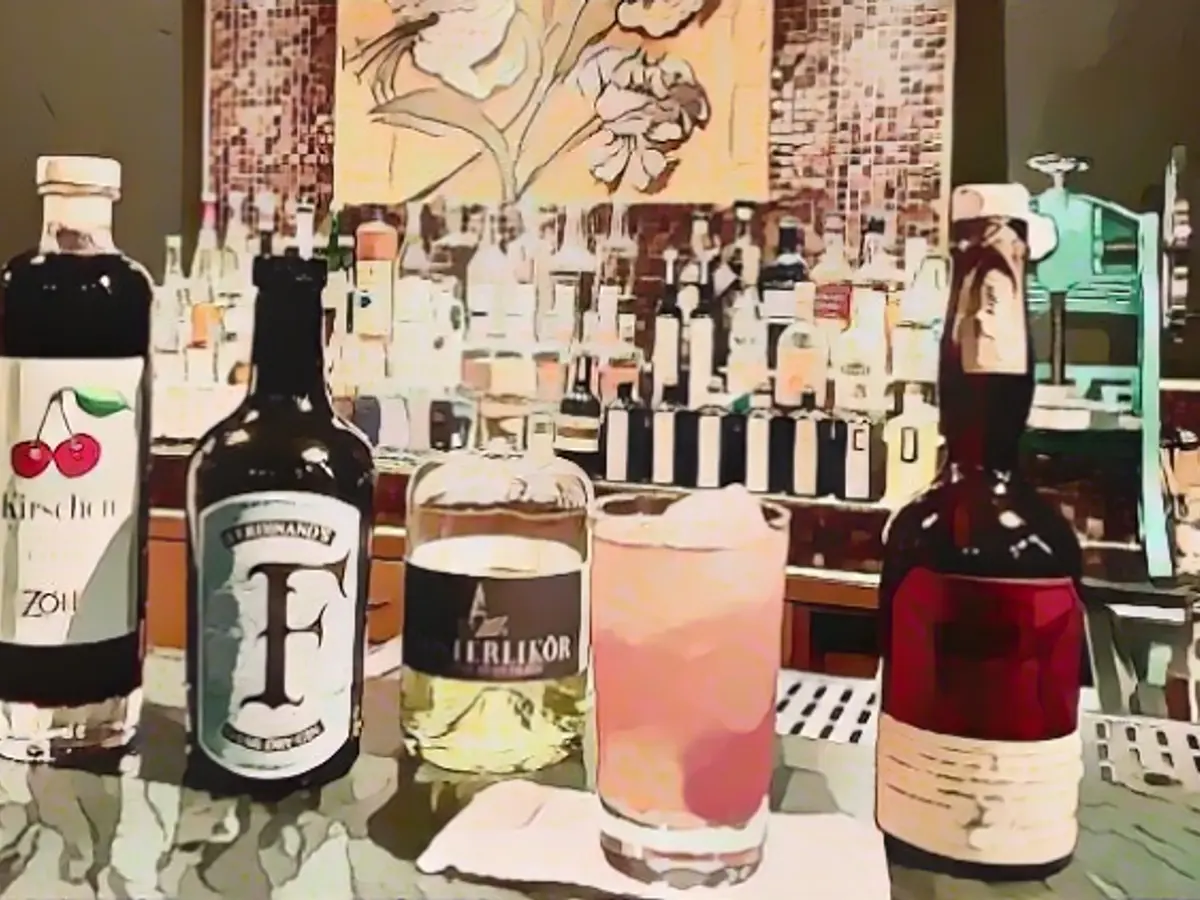
This mixology tour extended with "soda", i.e. sparkling water, originates from Singapore, where "Straits" was a place name. It is also known as the "Pink Singapore Sling". The reporter adds "Ferdinand" gin from Geltz Zilliken as the base spirit. From his bar shelf, Ebert conjures up a herbal liqueur from the Upper Bavarian monastery of St. Ottilien and sour cherry liqueur from the Bavarian distillery Zott. Add a shot of "Bogart's Bitter" from Bitter Truth and a squeeze of lemon. Whether stirred or shaken (before adding the carbon dioxide!) - the sling tastes refreshing! An incredibly good tactic for the fifth drink of the evening.
Fourth round: "Corpse Reviver No. 2"
At this point - after more than two hours, the barman's stomach has long been growling - just the right thing for the reporter: a shot of revival! Namely a "Corpse Reviver Number Two". Perfidiously, not with Red Bull or caffeine, but again high-proof and juniper-heavy: this time the "Schlossgin" from Schloss Johannisberg, the world's oldest Riesling vineyard in the Rheingau. In equal measure, the white "Dry Wermut" from Geltz Zilliken, a little less of the bitter orange liqueur from Spiritus Rex and a spoonful of absinthe from Preußische Spirituosenmanufaktur. Like shaking a body awake, this cocktail is awakened by shaking.
Last round: "Von Ribbeck"
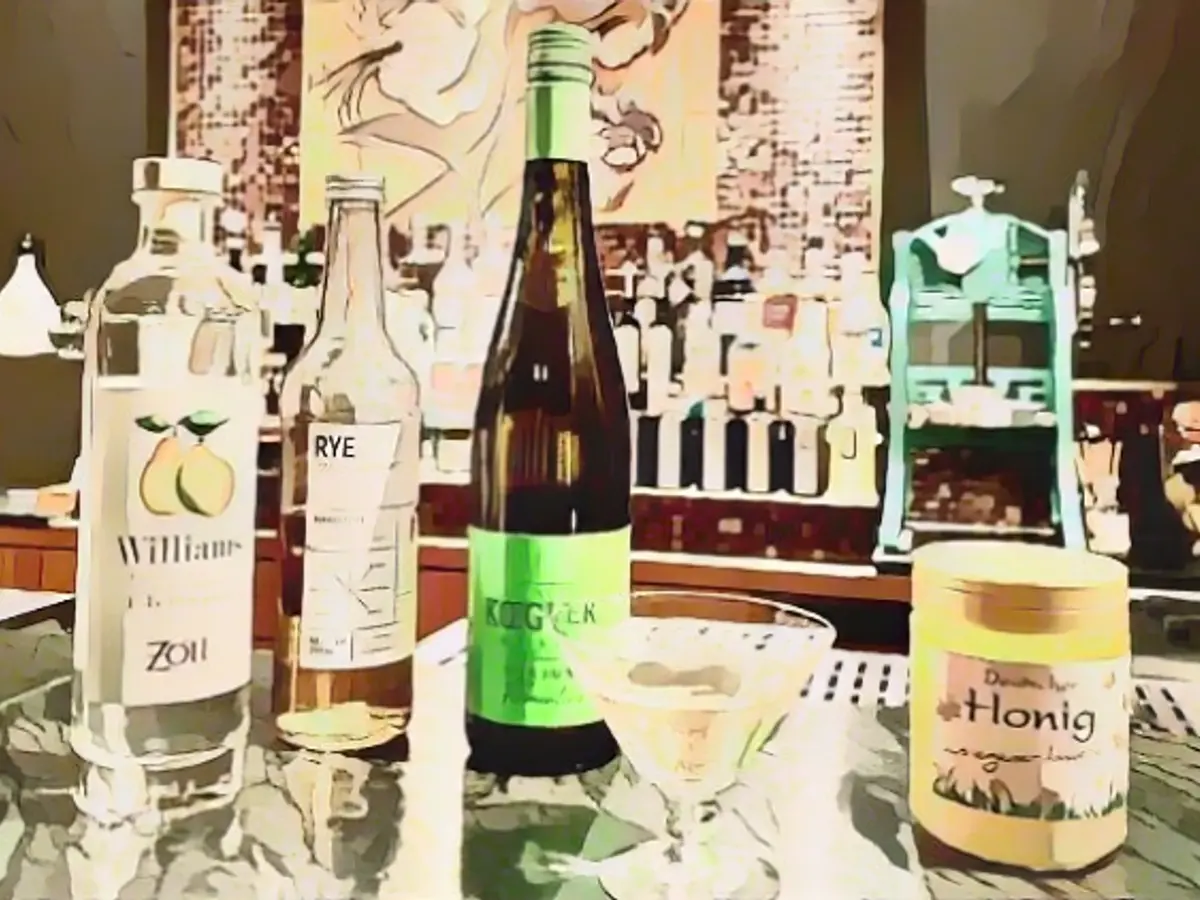
Oliver Ebert wants to eat and get rid of the reporter - but also quickly prepare a house recipe: "Von Ribbeck", named after "Herr von Ribbeck auf Ribbeck im Havelland", a liquid ode to the Brandenburg poet Theodor Fontane. If that's not a cultivated bouncer! He mixes Sasse's rye whisky with half Williams pear brandy from Zott in Bavaria and half verjus from Koegler (a young sour wine from the Rheingau - brrr!), a spoonful of blossom honey and a dash of "Old Times" bitters from Bitter Truth.
Afterwards, the reporter disappears into the evening in Prenzlauer Berg, visits the corner pub "Schusterjunge" for a portion of beef roulade - and is amazed at the massive wine list. More on this soon!
Read also:
- Snow chaos further restricts Bavaria
- Unanimous decision: faster wolf culls possible
- The year of climate records: extreme is the new normal
- Snow and ice paralyze southern Germany
In the spirit of exploring local ingredients, Oliver Ebert crafts a unique "Manhattan" using German rye whisky and vermouth, as well as a fruity bitter orange liqueur. The result is a drink that tastes like Christmas with clove, cinnamon, and star anise notes.
Discovering German spirits, the reporter also asks Ebert to experiment with a Mosel vermouth in cocktails. Using Loosen's Mosel vermouth, Ebert successfully concocts three different cocktails, showcasing the versatility of German-made liquors in mixology.
Source: www.ntv.de
